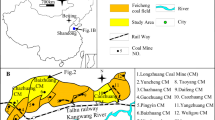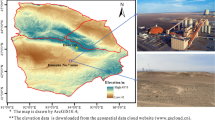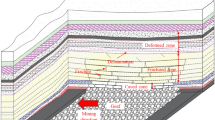Abstract
The mining of deep coal seams in the North China coalfields is threatened by the risk of water inrush from the Ordovician karst. As the mining depth increases, traditional methods of drainage depressurization and grouting reinforcement of the coal floor are increasingly ineffective at solving the problem of water inrush from the Ordovician karst. Grouting reinforcement of the Fengfeng Formation in the Ordovician (Ordovician top) was applied 10 years ago to solve this problem, prevalent recently, and mastering the vertical karst development is fundamental and prerequisite work. This paper carried out a study on the vertical karst development and grouting reinforcement of the Ordovician top in the Feicheng coalfield, China. Macroscopic and microscopic characteristics of the karst were researched by analysis of borehole cores and water inflow, slice identification and X-ray testing results to reveal the vertical karst development of the Ordovician top. Five layers were developed, from top to bottom: confining zone, fissure network zone, karst fissure and pore zone, karst channel zone and confining zone. Then the suitable grouting reinforcement layer was determined to be 5–45 m below the Ordovician top interface. The engineering practice of grouting reinforcement was carried out in the No. 8806 working face in the Baizhuang coal mine. The grouting technology and the evaluation of the grouting effect were analyzed comprehensively from the perspectives of the water inflow characteristics obtained from drilling and the apparent resistivity characteristics before and after grouting, which confirm the vertical karst development interpretation and good grouting effect. The study provides guidance for the prevention and control of Ordovician water disasters of the Feicheng coalfield, as well as other coal mines in North China.






















Similar content being viewed by others
References
Carpenter PJ, Breuer E (2004) Seismic tomographic imaging of buried karst features. Symposium on the Application of Geophysics to Engineering and Environmental Problems, pp 1114–1124
Chen W, Xue G, Olatayo AL, Chen K, Khan MY (2017) A comparison of loop time-domain electromagnetic and short-offset transient electromagnetic methods for mapping water-enriched zones—a case history in Shaanxi, China. Geophysics 82(6):201–208. https://doi.org/10.1190/geo2017-0070.1
Crrens JC, Crawfordetal (2004) Karst potential and development indices: tools for mapping karst using GIS. In: Denver Annual Meeting, pp 7–10
Filipponi M, Schmassmann S, Jeannin PY, Parriaux A (2012) Karst ALEA: Wegleitung zur Prognose von karst spezifischen Gefahren im Untertagbau (Karst ALEA, a practical guide for the prediction of karst-related hazards in underground works) - Forschungsprojekt FGU 2009/003 des Bundesamt für Strassen ASTRA. Schweizerischer Verband der Strassen- und Verkehrsfachleute VSS, Zürich, p 200
Folk R (1959) Practical petrographic classification of lime stones. AAPG 1959(43):10–15
Gao W, Shi L, Ma J, Niu C, Xiao M (2015) Calculation formula derivation of grouting reconstruction depth at the top of Ordovician limestone and its application. Saf Coal Mines China 46(8):199–201
Gao W, Shi L, Zhai P (2019) Water detection within the working face of an underground coal mine using 3D electric resistivity tomography (ERT). J Environ Eng Geophys 24(3):497–505. https://doi.org/10.2113/JEEG24.3.497
Gu X, Wang J, Liu Y (2010) Water resistant features of high-risk outburst coal seams and standard discriminant model of mining under water pressure. Min Sci Technol 20:0797–0802
Li P (2018) Research on slurry diffusion law of horizontal grouting hole in Ordovician karst fissure aquifer. Master Thesis, Graduate School of China Research Institute, Beijing
Li ZX, Wang DD, Lv DW, Li Y, Liu H, Wang P, Liu Y, Liu J, Li D (2018) The geologic settings of Chinese coal deposits. Int Geol Rev 60:548–578. https://doi.org/10.1080/00206814.2017.1324327
Nan S (2010) Technical feasibility of grouting reform for upper part of Ordovician limestone in Xingtai and Handan coal mining areas. Coal Geol Explor 38(3):37–40
Perkins RB (1971) The hydrogeology and geomorphology of karst features in the cumberland mountain pilot tunne. Eastern Kentucky University
Qian D, Zhang N, Zhang M, Shimada H, Cao P, Chen Y, Wen K, Yang S, Zhang N (2017) Application and evaluation of ground surface pre-grouting reinforcement for 800-m-deep underground opening through large fault zones. Arab J Geosci 10:285. https://doi.org/10.1007/s12517-017-3052-7
Qiu M (2016) Karst development and grouting reinforcement of Ordovician top in Feicheng coalfield. PhD Thesis, Qingdao University, Qingdao
Qiu M, Han J, Zhou Y, Shi LQ (2017a) Prediction reliability of water inrush through the coal mine floor. Mine Water Environ 36(2):217–225. https://doi.org/10.1007/s10230-017-0431-y
Qiu M, Shi LQ, Teng C, Zhou Y (2017b) Assessment of water inrush risk using the fuzzy delphi analytic hierarchy process and grey relational analysis in the Liangzhuang coal mine, China. Mine Water Environ 36(1):39–50
Qu X, Qiu M, Liu J, Niu Z, Wu X (2019) Prediction of maximal water bursting discharge from coal seam floor based on multiple nonlinear regression analysis. Arab J Geosci 12(18):567. https://doi.org/10.1007/s12517-019-4748-7
Shi LQ, Bo CS, Wei JC (2015) Control theory and technology of Ordovician limestone karst water inrush in North China coalfield. China Coal Industry Publ. House, Beijing
Shi L, Gao W, Han J, Tan X (2017) A nonlinear risk evaluation method for water inrush through the seam floor. Mine Water Environ 36(4):597–605. https://doi.org/10.1007/s10230-017-0449-1
Shi LQ, Qiu M, Wang Y, Qu X, Liu T (2019) Evaluation of water inrush from underlying aquifers by using a modified water-inrush coefficient model and water-inrush index model: a case study in Feicheng coalfield, China. Hydrogeol J 27:2105–2211. https://doi.org/10.1007/s10040-019-01985-2
Su W (2012) The feasibility analysis on the transformation of the Ordovician limestone top grouting in the Xingtai mining area. Hebei Coal 1(1–2):20
Sun W, Wu Q, Liu H, Jiao J (2015) Prediction and assessment of the disturbances of the coal mining in Kailuan to karst groundwater system. Phys Chem Earth 89–90:136–144
Tan Y, Zhao TB, Xiao YX (2010) Researches on floor stratum fracturing induced by antiprocedure mining underneath close-distance goaf. J Min Sci 46(3):250–259
Teng C, Qiu M, Han J, Shi LQ (2015) Horizontal distribution characteristic of Ordovician karst in Feicheng coalfeld. Coal Technol 34(9):118–120
Wang X, Meng F (2018) Statistical analysis of large accidents in China's coal mines in 2016. Nat Hazards 92(1):311–325
Wu Q, Zhou W (2008) Prediction of groundwater inrush into coal mines from aquifers underlying the coal seams in China: vulnerability index method and its construction. Environ Geol 55(4):245–254. https://doi.org/10.1007/s00254-007-1160-5
Wu Q, Xu H, Pang W (2008) GIS and ANN coupling model: an innovative approach to evaluate vulnerability of karst water inrush in coalmines of north China. Environ Geol 54:937–943. https://doi.org/10.1007/s00254-007-0887-3
Wu Q, Liu Y, Liu D, Zhou W (2011) Prediction of floor water inrush: the application of GIS-based AHP vulnerable index method to Donghuantuo coal mine, China. Rock Mech Rock Eng 44:591–600. https://doi.org/10.1007/s00603-011-0146-5
Wu Q, Jiang L, Wu Q (2017a) Study on the law of mining stress evolution and fault activation under the influence of normal fault. Acta Geodynamica Et Geomaterialia 14(3):357–369
Wu Q, Zhao D, Wang Y, Shen J, Mu W (2017b) Method for assessing coal-floor water-inrush risk based on the variable-weight model and unascertained measure theory. Hydrogeol J 25:2089–2103. https://doi.org/10.1007/s10040-017-1614-0
Yin H, Shi Y, Niu H, Xie D, Wei J, Lefticariu L, Xu X (2018) A GIS-based model of potential groundwater yield zonation for a sandstone aquifer in the Juye Coalfield, Shangdong, China. J Hydrol 557:434–447. https://doi.org/10.1016/j.jhydrol.2017.12.043
Zhang S, Guo W, Li Y (2017) Experimental simulation of water-inrush disaster from the floor of mine and its mechanism investigation. Arab J Geosci 10(22):503. https://doi.org/10.1007/s12517-017-3287-3
Zhao D, Wu Q, Cui F, Xu H, Zeng Y, Cao Y, Du Y (2018) Using random forest for the risk assessment of coal-floor water inrush in Panjiayao coal mine, northern China. Hydrogeol J 26(7):2327–2340. https://doi.org/10.1007/s10040-018-1767-5
Acknowledgements
The authors would like to acknowledge the financial support of the National Natural Science Foundation of China (51804184, 41572244, 41807283), the Shandong Province Nature Science Fund (ZR2015DM013), and the Scientific Research Foundation of Shandong University of Science and Technology for Recruited Talents (2017RCJJ033).
Author information
Authors and Affiliations
Corresponding author
Additional information
Publisher's Note
Springer Nature remains neutral with regard to jurisdictional claims in published maps and institutional affiliations.
Rights and permissions
About this article
Cite this article
Qiu, M., Huang, F., Wang, J. et al. Characteristics of vertical karst development and grouting reinforcement engineering practice of the Ordovician top in the Feicheng coalfield, China. Carbonates Evaporites 35, 78 (2020). https://doi.org/10.1007/s13146-020-00611-7
Accepted:
Published:
DOI: https://doi.org/10.1007/s13146-020-00611-7




